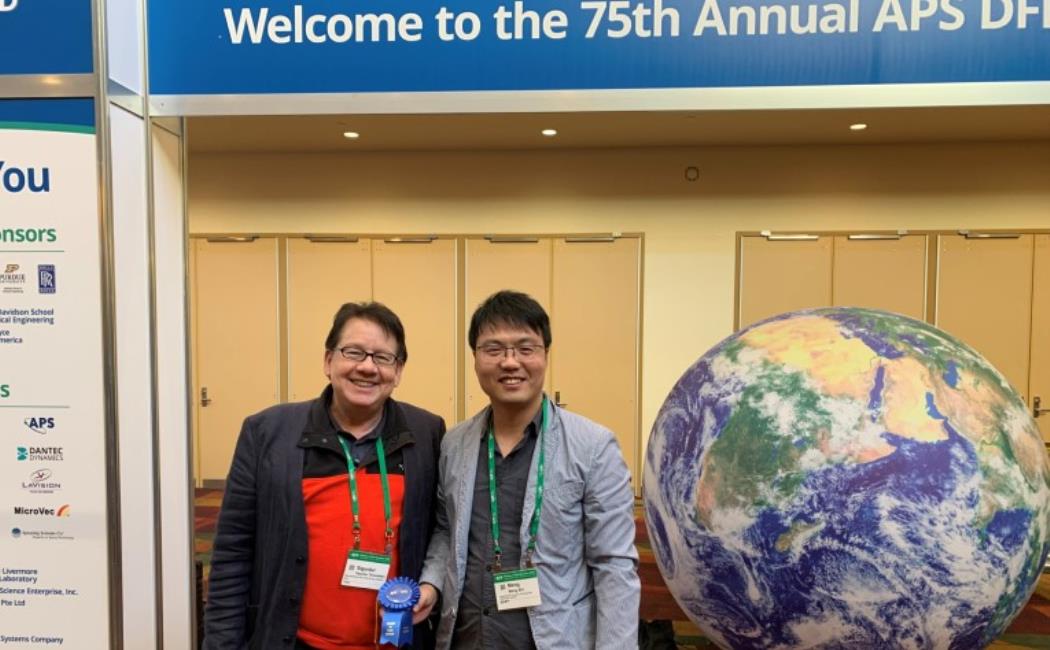

LATEST
NEWS

18 December, 2022
By David Murphy
The research work of KAUST postdoctoral fellow Meng Shi and Professor of Mechanical Engineering Sigurdur Thoroddsen was announced as a Milton Van Dyke Award Poster Winner at the 75th Annual Meeting of The American Physical Society (APS)’s Division of Fluid Dynamics (DFD). The meeting was held from November 20 to 22, 2022, in Indianapolis, U.S.
Established in 1947, the APS’s DFD exists for the advancement and diffusion of knowledge of the physics of fluids with special emphasis on the dynamical theories of the liquid, plastic and gaseous states of matter under all temperature conditions and pressure.
Since 1987, the Gallery of Fluid Motion competition has illustrated the science of fluid motion with striking visualizations of experiments and simulations. Each year, attendees submit videos and posters to the event demonstrating the beauty of fluids and tackling the scientific questions behind them.
This year, a panel of judges evaluated 115 entries—82 videos and 33 posters—and selected 12 winners. The top three winners in both categories (video and poster) received the designation of Milton Van Dyke Award winners. The awards are named after the influential American fluid mechanics professor, Milton Van Dyke.
“We were excited and surprised when we received the poster award,” Shi said of their recent win. “The Gallery of Fluid Motion committee members are professional scientists of fluid mechanics, [so] we are glad they recognized our work,” Thoroddsen added.
“Our win is particularly satisfying, as our group has not received the Milton Van Dyke Award for several years. The award encourages us to advance our studies.”
"Mushroom Vortex Street"
The researchers received the Gallery of Fluid Motion award for their entry titled "Mushroom Vortex Street." The winning poster is based on Shi and Thoroddsen’s research on the formation of a street of mushroom vortices when a liquid drop impacts on a thin miscible liquid film.
Through high-speed imaging, the KAUST researchers observed that the vortex street was created by the undulations of the liquid interfaces and reinforced by the surface tension instability following the impact. The study offers new insight into the physics of mixing when drops impact a miscible liquid film, which could be useful in blending solutions, spray coatings and chemical reactions.
“When a liquid drop impacts on a thin miscible liquid film, it breaks into a central drop and a surrounding liquid ring. We observed the formation of a street of mushroom vortex (~1 mm) in the liquid ring at initial contact (~100 ms) due to surface tension instability. This vortex street enhances the mixing of liquids. Because of the minuscule temporal and spatial scales, this phenomenon only can be observed clearly by a high-speed camera with a microlens set-up,” Shi explained.
“We are working on the fundamental fluid mechanics problems of drop impact on solids, liquids or micro-structured surfaces. We often observe new phenomena through high-speed imaging and then reveal the physics behind them through systematic experiments and fundamental theories.” Thoroddsen noted.
Professor Thoroddsen’s research is in experimental fluid mechanics. Using ultra-high-speed video imaging, he studies the dynamics of free-surface flows and Tomographic Particle Image Velocimetry studies in turbulence.
Shi’s research focuses on interfacial fluids and heat transfer, including droplet impact, droplet behaviors on micro and nanostructures, Leidenfrost phenomenon and transport in porous media.
“We would like to acknowledge the superb support of KAUST,” Shi emphasized. “Thanks to the University’s advanced facilities and excellent research funding, we can continue performing high-quality research and pursue our scientific goals,” Thoroddsen concluded.